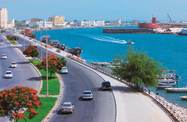Ras Al Khaimah’s (RAK) economy is on track to post a second year of solid growth. The emirate, however, is also keeping an eye on any signs of economic slowdown or political instability elsewhere in the region, which could impact its overall expansion.
The emirate’s GDP is expected to expand by 8% in 2012, the same rate of growth it saw in 2011, RAK’s ruler, Sheikh Saud Bin Saqr Al Qasimi, told local media in April. The glass and cement segments, which depend on the strong indigenous mining industry for their raw materials, as well as pharmaceuticals, continue to lead economic growth, with tourism quickly making up ground due to increasing investments from both the private and public sectors.
Inflation across the UAE, including in RAK, is not expected to pass 2% this year, which would be slightly up on the current 1.5% figure, according to the minister of economy, Sultan bin Saeed Al Mansouri. The strong growth posted by the emirate, however, could result in additional pressure due to rising consumer demand.
In early April, Fitch Ratings gave RAK a firm vote of confidence, affirming its long-term foreign and local currency Issuer Default Ratings (IDR) at “A”, with the outlook listed as stable. In its report, issued on April 5, Fitch said the emirate’s debt was easing down to around 20% of GDP, while the economy had recovered well from the global and regional crisis. Richard Fox, the head of Middle East and Africa Sovereign Ratings at Fitch, described the emirate’s ability to diversify markets and attract foreign investment as impressive.
“RAK continues to make steady progress reducing an already modest debt burden, executing a focused development strategy and improving data quality to track progress,” Fox said.
The report also said that RAK benefitted from the support of the UAE’s federal government, and in particular through the provision of basic social and physical infrastructure, along with the backing of the nation’s central bank.
The Fitch report supported the findings of an earlier study, carried out by global ratings agency Standard & Poor’s, which said RAK was posting sustained economic growth and government surpluses, and that as long as demand for its industrial products continued to be solid, the local economy should remain sound.
According to Sheikh Saud, the emirate is seeking to achieve a balance between the need to boost the economy while promoting social development.
“We want to promote industry and tourism, but at the same time we would like to see the quality of life in RAK improve, so we are also encouraging investors to look at schools, hospitals and other public amenities,” he said in a interview with Arabian Business in early April.
Citing a number of major infrastructure projects, including large-scale road links and the planned broad-gauge rail line that will connect the emirate with the rest of the country and eventually the wider Middle East, Sheikh Saud said the increased freight-moving capacity would allow the economy to expand further, especially given its growing focus on mining and industrial production.
Another area that could make an increased contribution to the economy is the oil and gas industry. Though home to limited deposits of hydrocarbons – identified reserves total around 33.96m cu metres of natural gas and 400m barrels of oil – efforts are being made to maximise output from existing fields and to locate new deposits.
As a result of these efforts, RAK’s oil sector is now attracting international interest. In mid-April, Lime Petroleum, a subsidiary of Malaysian firm Hibiscus Petroleum, was granted a new concession in RAK, covering 886 sq km in the south. The initial term of the exploration and production-sharing agreement is 18 months, with a second term covering two years.
Should the field be deemed commercially viable, the exploitation contract will run for 20 years, with a renewal option for a further five. Through Lime, Hibiscus Petroleum already has a stake in another RAK field, an offshore concession in the north.
In a statement to the Malaysian stock exchange on April 15, Hibiscus said that securing a second concession in RAK, “demonstrates that the business relationship between Lime and the regulatory authorities of the emirate is further strengthening, which could lead to more opportunities”.
Other investors are also seeing opportunities in RAK, with a number of major tourism and hospitality developments in the pipeline, including the forthcoming Real Madrid tie-up, which will see a $1bn resort and sporting complex themed around the Spanish footballing giant take shape over the next few years.
The increasing focus on tourism has seen visitor numbers up by almost 50% in the first three months of 2012 compared to the same quarter in 2011, with hotel revenues jumping by 40%, local media has reported. RAK has targeted 1.2m visitors for 2013, and as many as twice this figure by 2016, part of a programme to further diversify the economy.
Though at least some of RAK’s forecast 8% GDP growth will be dependent on the health of its export markets, the general outlook is good. With declining debt levels, rising budgetary reserves and increasing investor interest, RAK is poised to see growth in 2012 rival last year’s expansion.

